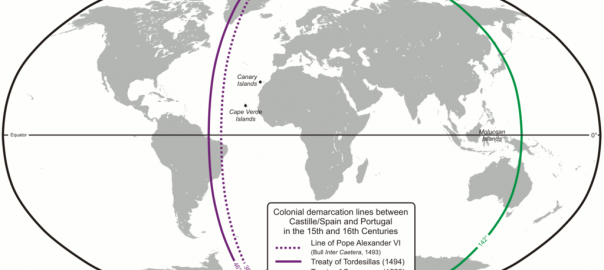Through the first decade of this project, I have been gaining a more robust picture of the ways in which the explosion of “Western” imperial/colonial power upon the world outside Europe was linked to developments inside Europe itself. Case Study #1 for that was of course the synchronicity between Ferdinand and Isabella’s reconquista of the last Muslim-led city-state in Iberia– Granada– and their dispatch of Columbus on his trans-oceanic voyage to the west (hoping to get to India)…
Anyway, 1529 CE saw three key developments inside Europe that soon afterwards would strongly affect the balance of power worldwide… as well as one intriguing development outside Europe.
First, the intra-Europe developments:
- In April, Portugal and Spain concluded the Treaty of Zaragoza (which is a city in Aragon, Spain.) This treaty was supposed to mirror/complement in the Indian Ocean/Pacific world the arrangement the two had reached in the 1494 Treaty of Tordesillas. Tordesillas had divided exploration/conquest rights in Atlantic world between these two leading Catholic-European aspirants to world domination; and like Tordesillas, Zaragoza sought to draw a straight north-south (longitudinal) line of demarcation– and it was originally supposed to be exactly 180 degrees opposite the Tordesillas line. Portugal would “get” everything stretching from the Tordesillas line east to the Zaragoza line, and Spain everything west from Tordesillas to Zaragoza. It did not work out quite like that and did not resolve everything. It was notable that while Tordesillas had been intermediated by the Pope, by 1529 the Pope was so weak relative to Charles V of Spain that the two sides negotiated it directly. Anyway, conclusion of the Treaty of Zaragoza strongly facilitated the continuation and expansion of the imperial/colonial projects of both signatory powers.
-

Habsburg lands in Europe, 1547 In May, Suleiman the Magnificent led an Ottoman military campaign that besieged Vienna, seeking to conquer it (and probably many of the lands around/beyond it.) Vienna was part of the patchwork of lands stretching across Europe that came under the sway of the “Holy Roman Emperor”, who was Charles V of Spain. Suleiman led the campaign himself. But like Napoleon’s (much lengthier) push for Moscow 283 years later, Suleiman’s campaign against Vienna ended in failure. Unlike Napoleon, however, Suleiman was able to organize an orderly retreat: he gave the order in October, as winter set in. (He tried to take Vienna again in 1532, but that also failed.) From then on, the Ottomans’ ability to wield power in south/central Europe had a fairly clear operational limit. The attack on Vienna also led to a rapprochment between Charles V and the Pope, who in February 1530 agreed to crown Charles as the Holy Roman Emperor (that is, he recognized the titles Charles had already given himself.)
- In October, in London, King Henry VIII summoned a new session of parliament to deal with a request he had made in 1527 for an annulment of his marriage to Catherine of Aragon. She was the Spanish king’s aunt. More important, from Henry’s perspective, was the fact that she had failed to bear him a son and was judged past child-bearing age. (Also, his kingly eyes and other body parts had strayed to first Mary Boleyn, then her sister Anne.) Henry had sent the 1527 annulment request to the Pope, who refused to grant it. So now, he convened a new Reformation Parliament as a way of rallying English political/social forces against the Pope. In the seven years in which it sat, the parliament would curtail the powers of the Catholic church; confirm the annulment of Henry’s marriage to Catherine and the succession of Anne Boleyn’s children to the crown; and start the process of having the Church of England break from Roman Catholicism completely.
… And the major non-European development of 1529 that I identified was this one, from English-WP’s intriguing and detailed Ming dynasty timeline:
-

Chinese navigational map of 15-16th century CE showing coast of Africa at bottom, and Ceylon Several commanders at Wenzhou were exiled for consorting with what were called “pirates”, in response to what the Ming chroniclers called the Jiajing wokou raids (嘉靖大倭寇 or 嘉靖倭亂). That whole English-WP page on the raids is worth reading as it gives good background to the wariness with which the Ming viewed the possibility of maritime trade in that era, which was probably still in backlash to the earlier era (1405 – 1433 CE) in which they’d sent massive “treasure voyages” under Admiral Zheng He, far around the Indian Ocean including to East Africa…
